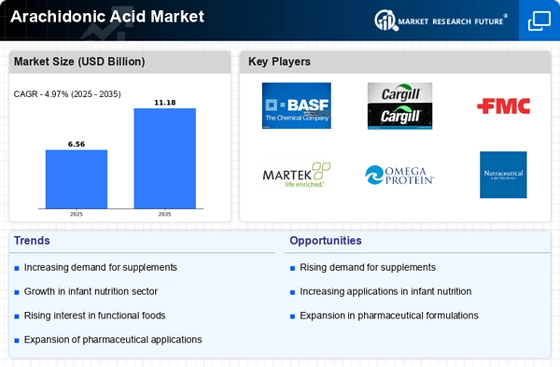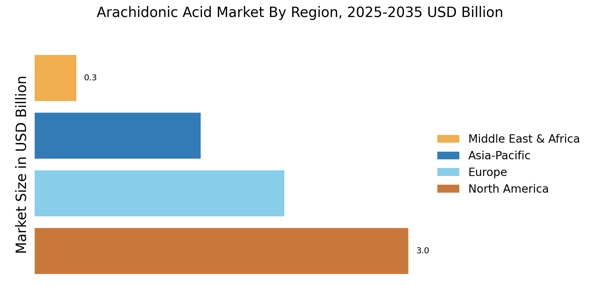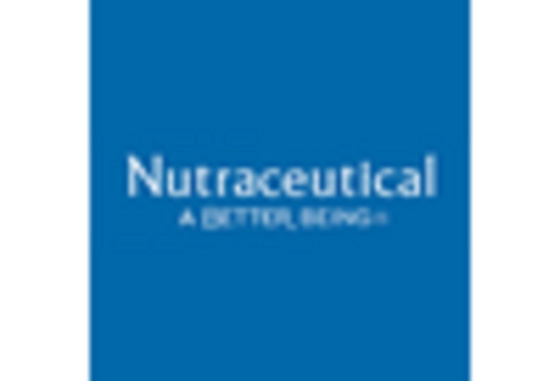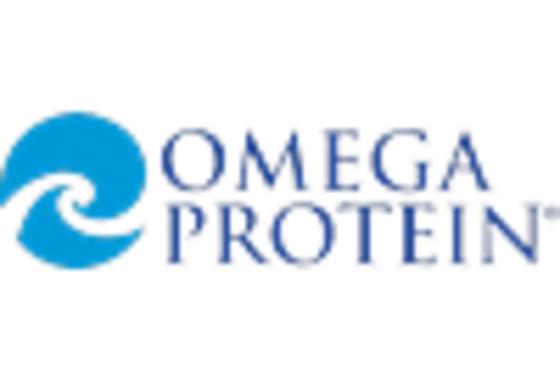The Arachidonic Acid Market is currently characterized by a dynamic competitive landscape, driven by increasing demand for nutritional supplements and functional foods. Key players such as BASF SE (Germany), Cargill, Incorporated (US), and DSM Nutritional Products (Switzerland) are strategically positioned to leverage their extensive research and development capabilities. These companies are focusing on innovation and product differentiation to capture market share, while also exploring partnerships and acquisitions to enhance their operational efficiencies. The collective strategies of these firms contribute to a moderately fragmented market structure, where competition is intensifying as companies seek to establish a foothold in emerging markets.
In terms of business tactics, companies are increasingly localizing manufacturing to reduce costs and improve supply chain resilience. This approach not only enhances their ability to respond to regional demand fluctuations but also aligns with sustainability goals. The market structure remains moderately fragmented, with several players vying for dominance. The influence of major companies is significant, as they set trends in product development and market strategies, thereby shaping the overall competitive environment.
In August 2025, BASF SE (Germany) announced the launch of a new line of Arachidonic Acid Market-based products aimed at the infant nutrition sector. This strategic move is particularly noteworthy as it aligns with the growing consumer preference for specialized nutritional products. By targeting this niche market, BASF SE is likely to enhance its competitive edge and expand its market presence, capitalizing on the increasing awareness of the importance of Arachidonic Acid Market in early development.
In September 2025, Cargill, Incorporated (US) revealed a partnership with a leading biotechnology firm to develop sustainable sources of Arachidonic Acid Market. This collaboration underscores Cargill's commitment to sustainability and innovation, as it seeks to address the rising consumer demand for environmentally friendly products. The strategic importance of this partnership lies in its potential to position Cargill as a leader in sustainable Arachidonic Acid Market production, thereby appealing to a growing segment of eco-conscious consumers.
In July 2025, DSM Nutritional Products (Switzerland) expanded its production capabilities by investing in a new facility dedicated to the production of Arachidonic Acid Market. This investment reflects DSM's focus on meeting the increasing global demand for high-quality nutritional ingredients. The strategic significance of this expansion is multifaceted; it not only enhances DSM's production capacity but also reinforces its commitment to quality and innovation in the nutritional sector.
As of October 2025, the Arachidonic Acid Market is witnessing trends that emphasize digitalization, sustainability, and the integration of artificial intelligence in production processes. Strategic alliances are becoming increasingly prevalent, as companies recognize the value of collaboration in navigating complex market dynamics. Looking ahead, competitive differentiation is expected to evolve, shifting from traditional price-based competition to a focus on innovation, technological advancements, and supply chain reliability. This transition may redefine the competitive landscape, compelling companies to adapt and innovate continuously.


















Leave a Comment